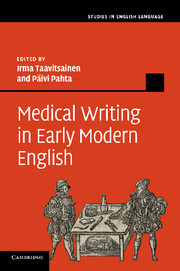Book contents
- Frontmatter
- Contents
- List of plates
- List of figures
- List of tables
- Notes on contributors
- Preface
- List of abbreviations
- 1 An interdisciplinary approach to medical writing in Early Modern English
- 2 Medical texts in 1500–1700 and the corpus of Early Modern English Medical Texts
- 3 Medical literacies and medical culture in early modern England
- 4 Verbs of knowing: discursive practices in early modern vernacular medicine
- 5 Defining in Early Modern English medical texts
- 6 Dissemination and appropriation of medical knowledge: humoral theory in Early Modern English medical writing and lay texts
- 7 Code-switching in Early Modern English medical writing
- 8 New arguments for new audiences: a corpus-based analysis of interpersonal strategies in Early Modern English medical recipes
- 9 Efficacy phrases in Early Modern English medical recipes
- 10 Medical pamphlets: controversy and advertising
- 11 The development of specialized discourse in the Philosophical Transactions
- 12 The expression of stance in early (1665–1712) publications of the Philosophical Transactions and other contemporary medical prose: innovations in a pioneering discourse
- Appendix A Raw data tables corresponding to Figures 4.3–4.14
- Appendix B Raw data tables corresponding to Figures 8.1–8.4
- Appendix C Stance markers used in the analysis in Chapter 12
- Appendix D Preliminary list of texts in the corpus of Early Modern English Medical Texts (EMEMT)
- Bibliography
- Index
4 - Verbs of knowing: discursive practices in early modern vernacular medicine
Published online by Cambridge University Press: 03 May 2011
- Frontmatter
- Contents
- List of plates
- List of figures
- List of tables
- Notes on contributors
- Preface
- List of abbreviations
- 1 An interdisciplinary approach to medical writing in Early Modern English
- 2 Medical texts in 1500–1700 and the corpus of Early Modern English Medical Texts
- 3 Medical literacies and medical culture in early modern England
- 4 Verbs of knowing: discursive practices in early modern vernacular medicine
- 5 Defining in Early Modern English medical texts
- 6 Dissemination and appropriation of medical knowledge: humoral theory in Early Modern English medical writing and lay texts
- 7 Code-switching in Early Modern English medical writing
- 8 New arguments for new audiences: a corpus-based analysis of interpersonal strategies in Early Modern English medical recipes
- 9 Efficacy phrases in Early Modern English medical recipes
- 10 Medical pamphlets: controversy and advertising
- 11 The development of specialized discourse in the Philosophical Transactions
- 12 The expression of stance in early (1665–1712) publications of the Philosophical Transactions and other contemporary medical prose: innovations in a pioneering discourse
- Appendix A Raw data tables corresponding to Figures 4.3–4.14
- Appendix B Raw data tables corresponding to Figures 8.1–8.4
- Appendix C Stance markers used in the analysis in Chapter 12
- Appendix D Preliminary list of texts in the corpus of Early Modern English Medical Texts (EMEMT)
- Bibliography
- Index
Summary
Introduction
The concept of knowing is fundamental to the way we conceptualize the world around us – and to the way we discuss it. Being aware of what we know and do not know shapes our social and cultural landscape, situates us in relation to our neighbours, and, to paraphrase Francis Bacon's famous aphorism, either gives us power or deprives us of it. Unsurprisingly, the nature and properties of knowledge and knowing have been a commonplace throughout much of Western philosophy, playing a key role in both philosophy and theology since antiquity. In the sciences, the pursuit of new knowledge has been a central feature since the early modern period.
In medicine, perhaps more than in any other field, the traditional understanding of knowledge has consisted of two complementary properties: episteme, theoretical knowledge, and techne, knowledge associated with skill and practical ability. Medical practitioners have always acknowledged the need for both, but the understanding of how the two best relate to one another has been a point of great contention. During the Middle Ages and early Renaissance, the divide between theory and practice formed one basis for defining the relative roles of medical practitioners (see, for example, Siraisi 1990; Getz 1998; and French 2003). In this framework, university-trained physicians represented the epistemic side of medical knowledge, drawing on Aristotelian natural philosophy to understand the complicated theories of humoral balance that explained most ailments.
- Type
- Chapter
- Information
- Medical Writing in Early Modern English , pp. 44 - 73Publisher: Cambridge University PressPrint publication year: 2011
- 3
- Cited by



